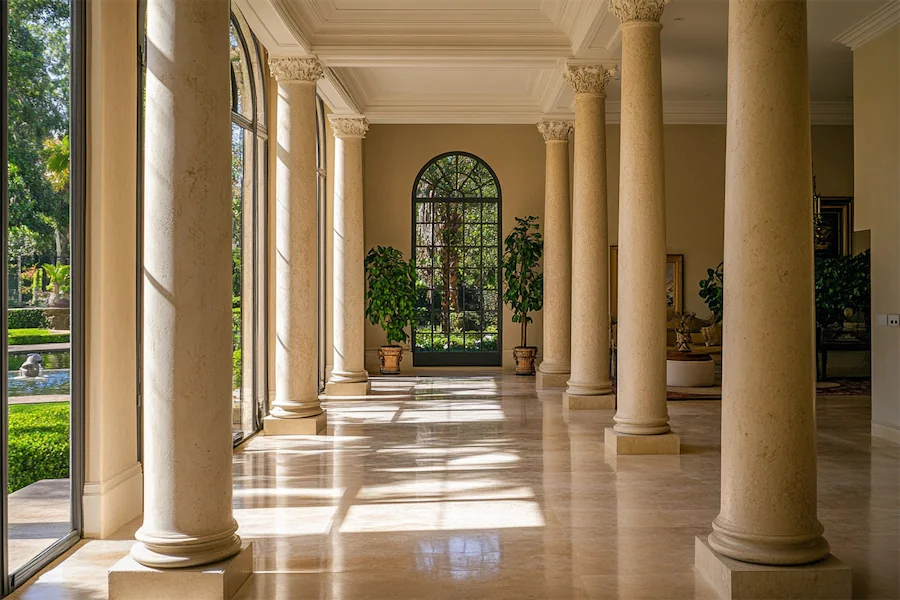English manor houses, emblematic of Britain’s architectural heritage, often feature columns that enhance their grandeur and reflect various historical styles. These columns serve both structural and decorative purposes, contributing to the stately presence of these residences.
Introduction to English Manor Columns
In English manor architecture, columns are integral elements that support porticos, frame entrances, and adorn interior spaces. Their design and application vary according to the architectural style and period, ranging from the robust forms of medieval times to the refined details of neoclassical influences.
Historical Evolution of English Manor Columns
The use of columns in English manor houses has evolved through several architectural periods:
- Medieval Period: Early manor houses featured minimal use of columns, focusing instead on heavy stone walls and timber frameworks. When present, columns were typically simple, sturdy, and functional, reflecting the utilitarian needs of the era.
- Tudor and Jacobean Eras (16th–17th centuries): During these periods, columns became more decorative, often featuring intricate carvings and supporting ornate arches within great halls and entranceways. The influence of Renaissance architecture introduced classical elements, leading to the incorporation of more refined column designs.
- Georgian Era (18th century): The Georgian period saw a shift towards classical architecture, characterized by symmetry, proportion, and the use of columns and pediments. Columns during this time were inspired by ancient Greek and Roman orders, adding elegance and formality to manor facades and interiors.
- Victorian Era (19th century): The Victorian era introduced a mix of styles, including Gothic Revival and Italianate, resulting in some of the most elaborate manor houses ever built. Columns from this period often featured elaborate detailing, reflecting the eclectic tastes of the time.
Key Features of English Manor Columns
English manor columns exhibit several distinctive characteristics:
- Classical Orders: Many columns adhere to the classical orders—Doric, Ionic, and Corinthian—each with unique proportions and decorative elements. The choice of order often reflects the architectural style and the desired expression of grandeur or elegance.
- Materials: Columns are typically constructed from stone or wood, materials that were readily available and allowed for intricate detailing. Stone columns, often seen in exterior applications, provide durability and a sense of permanence, while wooden columns are commonly used in interiors for their versatility and warmth.
- Design Details: Depending on the period, columns may feature fluting, ornate capitals, and bases with moldings. In neoclassical designs, columns are often smooth and unadorned, emphasizing proportion and symmetry, whereas Victorian-era columns may include elaborate carvings and decorative motifs.
Applications of Columns in English Manor Houses
Columns in English manor houses serve various functional and aesthetic roles:
- Entrances and Porticos: Columns often frame grand entrances, supporting pediments or porticos that provide shelter and create a formal approach to the residence. For example, Hylands Park Manor in Essex, designed in the neoclassical style, features a prominent portico with Ionic columns, enhancing its stately facade.
- Interior Spaces: Within manor houses, columns delineate spaces such as great halls, drawing rooms, and galleries. They may support arches or entablatures, contributing to the interior’s architectural rhythm and elegance. In some instances, columns are purely decorative, adding to the opulence of the space.
- Gardens and Conservatories: Columns are also utilized in garden structures and conservatories, reflecting the classical influences in landscape design. An example is the classic conservatory of an English manor residence, where white-fluted columns and a deep entablature define each window sash, supporting a lofty glass and iron roof.
Considerations for Incorporating Columns in English Manor Design
When designing or restoring columns in English manor houses, several factors should be considered:
- Architectural Consistency: It’s essential to ensure that the column design aligns with the overall architectural style of the manor. This includes selecting appropriate orders, proportions, and decorative details that reflect the period and aesthetic of the residence.
- Material Selection: Choosing materials that match or complement the existing structure is crucial for cohesion and authenticity. For historical restorations, sourcing materials similar to the original can preserve the manor’s integrity.
- Craftsmanship: High-quality craftsmanship is vital, especially when replicating intricate designs or ensuring structural stability. Engaging skilled artisans familiar with traditional techniques can result in columns that are both beautiful and durable.
Conclusion
Columns are a defining feature of English manor architecture, encapsulating the evolution of design aesthetics from medieval robustness to classical elegance. Their thoughtful incorporation enhances the grandeur and sophistication of manor houses, reflecting the rich architectural heritage of England.
